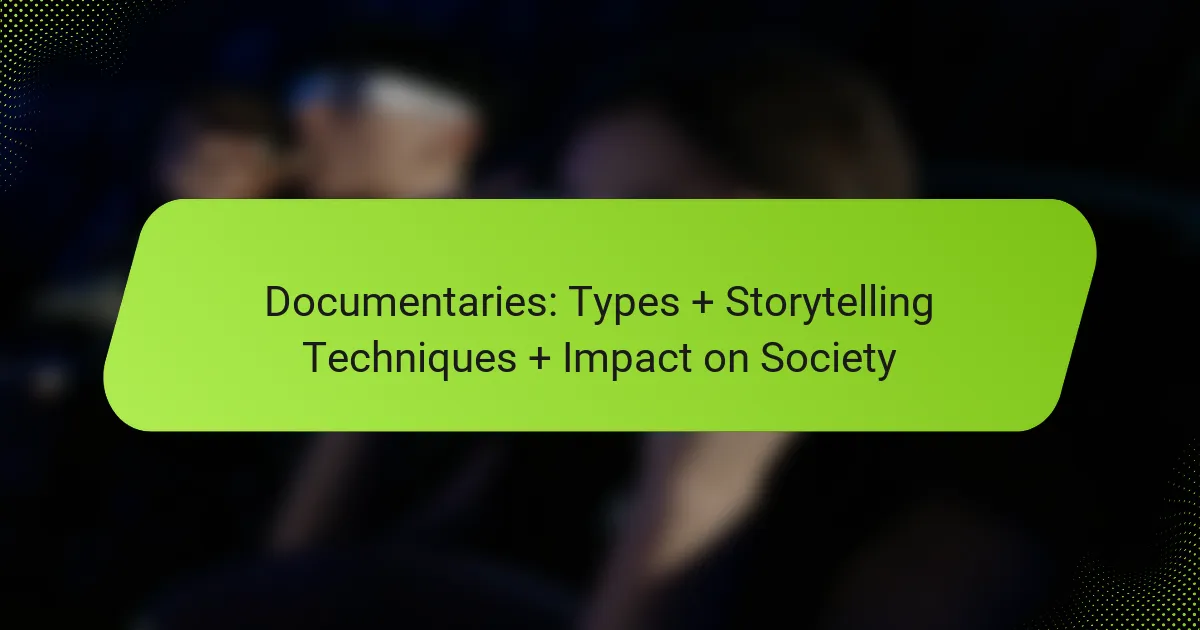
What are Documentaries?
Documentaries are non-fiction films that document reality for the purposes of instruction, education, or maintaining a historical record. They often explore real-life events, people, and social issues. Documentaries can take various forms, including observational, participatory, and expository styles. They aim to inform audiences through factual storytelling and visual evidence. The genre has evolved over time, with early examples dating back to the 1890s. Documentaries often employ interviews, archival footage, and expert commentary to provide context. According to a study by the University of Southern California, documentaries can significantly influence public opinion and awareness on critical issues. This highlights their role in shaping societal perspectives and driving change.
How do Documentaries differ from other film genres?
Documentaries differ from other film genres primarily in their commitment to factual representation. They focus on real events, people, and issues rather than fictional narratives. Documentaries often utilize interviews, archival footage, and observational footage to present their subjects. This genre aims to inform, educate, or provoke thought among viewers. Unlike fictional films, documentaries do not rely on scripted dialogue or actors. Instead, they present authentic experiences and perspectives. For example, the documentary “13th” explores the history of racial inequality in the United States through real interviews and historical footage. This emphasis on truth distinguishes documentaries from genres like drama or comedy, which prioritize storytelling over factual accuracy.
What key characteristics define Documentaries?
Documentaries are non-fiction films that aim to document reality. They often include real events, people, and places. Documentaries focus on factual storytelling rather than fictional narratives. They typically employ interviews, archival footage, and observational techniques. A key characteristic is their commitment to truth and authenticity. Documentaries often explore social, political, or cultural issues. They aim to inform, educate, or provoke thought among viewers. Many documentaries are structured around a central thesis or argument.
What are the primary purposes of creating Documentaries?
The primary purposes of creating documentaries include educating audiences, raising awareness, and preserving history. Documentaries aim to inform viewers about specific topics or issues. They often present factual information and insights. This can lead to increased public understanding and engagement. Documentaries also serve to highlight social, political, or environmental issues. By doing so, they can inspire action or change. Additionally, documentaries play a crucial role in documenting events and experiences. They capture stories that may otherwise be forgotten. This preservation of history ensures that future generations can learn from the past.
What are the various Types of Documentaries?
There are several types of documentaries. They include expository, observational, participatory, reflexive, and performative. Expository documentaries aim to inform and educate. They often include a narrator who presents facts and arguments. Observational documentaries focus on real-life situations without interference. They capture events as they happen. Participatory documentaries involve the filmmaker interacting with the subjects. This approach creates a dialogue between the filmmaker and the participants. Reflexive documentaries highlight the filmmaking process itself. They make the audience aware of the documentary’s construction. Performative documentaries emphasize the filmmaker’s personal experience. They often convey emotional truths rather than objective facts. Each type serves a unique purpose in storytelling and audience engagement.
What distinguishes Expository Documentaries from others?
Expository documentaries are distinguished by their informative approach and direct presentation of facts. They aim to educate the audience by explaining a particular subject or issue. These documentaries often use a voiceover narration to guide viewers through the content. This narrative style helps to clarify complex topics. Additionally, expository documentaries typically incorporate interviews, archival footage, and statistics. This combination enhances the credibility of the information presented. Their primary goal is to inform rather than to provoke emotional responses. This sets them apart from other documentary styles, such as observational or participatory documentaries.
How do Observational Documentaries engage audiences?
Observational documentaries engage audiences by presenting real-life events without scripted dialogue. This approach allows viewers to experience situations as they unfold naturally. The use of long takes and minimal interference fosters a sense of authenticity. Audiences connect emotionally with the subjects portrayed, enhancing their engagement. Studies show that viewers often feel a deeper empathy for real people compared to fictional characters. This emotional connection can lead to increased awareness of social issues. Additionally, observational documentaries often encourage critical thinking by presenting multiple perspectives. This format invites viewers to draw their own conclusions about the subject matter.
What role do Participatory Documentaries play in storytelling?
Participatory documentaries play a crucial role in storytelling by involving the subjects in the filmmaking process. This approach fosters a deeper connection between the filmmakers and the participants. The subjects share their perspectives and experiences, adding authenticity to the narrative. Participatory documentaries often highlight underrepresented voices and issues. They encourage audience engagement through personal stories and lived experiences. This format can lead to social change by raising awareness about specific topics. Research indicates that participatory methods enhance empathy and understanding among viewers. Overall, participatory documentaries enrich storytelling by creating collaborative narratives that resonate on a personal level.
What are the features of Reflexive Documentaries?
Reflexive documentaries are characterized by their self-awareness and critical examination of the documentary form. They often include the filmmaker’s presence within the narrative. This style invites viewers to question the authenticity of the documentary. Reflexive documentaries frequently challenge traditional storytelling techniques. They emphasize the constructed nature of reality in film. These documentaries may also blur the line between fiction and nonfiction. They encourage audience engagement through a reflective viewing experience. Notable examples include “Chronicle of a Summer” by Jean Rouch and “The Act of Killing” by Joshua Oppenheimer.
What Storytelling Techniques are used in Documentaries?
Documentaries use various storytelling techniques to engage audiences and convey information. These techniques include interviews, which provide personal insights and expert opinions. Archival footage is often utilized to add historical context and authenticity. Voiceovers narrate the story, guiding viewers through the content. Additionally, visual storytelling employs cinematography to evoke emotions and highlight key themes.
Another technique is the use of music and sound design to enhance the narrative. This can create mood and emphasize particular moments. Case studies and real-life examples are also common, illustrating the documentary’s central message. Finally, a strong narrative structure, often following a clear beginning, middle, and end, helps to maintain viewer interest and comprehension.
How do Narrative Structures enhance Documentary storytelling?
Narrative structures enhance documentary storytelling by providing a framework for organizing content. They guide the audience through the film’s themes and messages. A well-defined narrative structure creates emotional engagement. This engagement keeps viewers interested and invested in the story. For example, the classic three-act structure helps build tension and resolution. It allows for a clear beginning, middle, and end. Documentaries like “13th” utilize this structure to effectively convey complex social issues. This approach helps audiences understand and retain information. Overall, narrative structures are essential for impactful documentary storytelling.
What is the impact of Visual and Audio Elements in Documentaries?
Visual and audio elements significantly enhance the storytelling in documentaries. They create emotional connections with the audience. Visuals like images and footage provide context and illustrate key points. Audio elements, including narration and soundtracks, enrich the viewer’s experience. Research indicates that 65% of people are visual learners, underscoring the importance of visuals. Effective audio can evoke specific emotions, guiding audience reactions. Together, these elements help convey complex themes and messages. They also enhance retention of information, making documentaries more impactful.
How do Interviews shape the narrative in Documentaries?
Interviews shape the narrative in documentaries by providing personal perspectives and firsthand accounts. They serve as a primary source of information and emotional resonance. Interviews allow filmmakers to present diverse viewpoints, adding depth to the story. They can reveal motivations, emotions, and experiences that statistics alone cannot convey. The selection of interview subjects influences the narrative direction significantly. For example, interviewing experts adds credibility, while personal stories create relatability. Documentaries like “Won’t You Be My Neighbor?” use interviews to highlight key themes and humanize the subject. The structure of interviews can also guide the pacing and flow of the documentary. Thus, interviews are crucial in crafting a compelling and engaging narrative.

How do Documentaries impact Society?
Documentaries impact society by educating viewers and raising awareness on critical issues. They provide in-depth exploration of topics like climate change, social justice, and health. This exposure can lead to increased public discourse and inspire action. For example, “An Inconvenient Truth” significantly raised awareness about global warming. Documentaries can also influence policy changes by presenting compelling evidence. They often highlight marginalized voices, fostering empathy and understanding. Research shows that documentaries can change perceptions and behaviors. A study published in the Journal of Communication found that viewers of social issue documentaries were more likely to engage in activism. Overall, documentaries serve as powerful tools for social change and awareness.
What social issues do Documentaries often address?
Documentaries often address various social issues, including poverty, inequality, and environmental concerns. They highlight systemic problems affecting communities and individuals. For instance, documentaries like “13th” examine racial inequality in the U.S. justice system. Others, such as “Food, Inc.,” investigate the impact of industrial agriculture on health and the environment. Documentaries also tackle topics like mental health, immigration, and human rights abuses. They serve to raise awareness and prompt discussions on these critical issues. By presenting real-life stories and statistics, documentaries can influence public opinion and policy change.
How do Documentaries raise awareness about critical topics?
Documentaries raise awareness about critical topics by presenting factual narratives that inform and engage audiences. They utilize compelling storytelling techniques to highlight social issues, environmental concerns, and human rights violations. Through interviews, expert insights, and real-life footage, documentaries provide a platform for underrepresented voices. This method fosters empathy and understanding among viewers. Statistics show that documentaries can influence public opinion and inspire action. For example, the documentary “An Inconvenient Truth” significantly raised awareness about climate change, leading to increased public discourse and policy initiatives. By combining emotional appeal with factual information, documentaries effectively drive awareness and spark conversations around important issues.
What role do Documentaries play in shaping public opinion?
Documentaries play a significant role in shaping public opinion by presenting factual narratives that inform and educate viewers. They often address social issues, historical events, or cultural phenomena. By using real-life footage and expert interviews, documentaries provide a compelling context for understanding complex topics. This visual storytelling can evoke emotional responses, making the subject matter more relatable. Studies show that documentaries can influence viewers’ attitudes and perceptions. For instance, research indicates that watching a documentary about climate change can increase awareness and concern among audiences. The persuasive power of documentaries lies in their ability to humanize issues and present diverse perspectives.
How can Documentaries influence cultural perspectives?
Documentaries can significantly influence cultural perspectives by presenting factual narratives that challenge existing beliefs. They often explore diverse cultures, social issues, and historical events. This exposure can foster empathy and understanding among viewers. For example, documentaries like “13th” highlight systemic racism in America, prompting discussions on race relations. Research indicates that viewing documentaries can increase awareness and change attitudes towards social issues. A study by the University of Southern California found that documentaries can lead to greater civic engagement and activism. By providing a platform for marginalized voices, documentaries can reshape cultural narratives and inspire societal change.
What examples illustrate Documentaries changing cultural narratives?
“13th” illustrates how documentaries can change cultural narratives by addressing systemic racism in the U.S. It highlights the connection between slavery and mass incarceration. The film presents historical evidence and expert interviews to support its claims. “Blackfish” changed perceptions about orca captivity in marine parks. It revealed the negative impacts on both the animals and their trainers. The documentary led to significant public backlash against SeaWorld. “Won’t You Be My Neighbor?” shifted the narrative around children’s television. It showcased Fred Rogers’ emphasis on kindness and emotional intelligence. This documentary reignited discussions about empathy in media. These examples demonstrate how documentaries can reshape societal views. They provide factual evidence that influences public opinion and policy.
How can Documentaries promote social change?
Documentaries can promote social change by raising awareness about critical issues. They educate viewers on topics such as climate change, social justice, and human rights. By presenting real-life stories, documentaries evoke empathy and inspire action. For instance, “An Inconvenient Truth” significantly increased public discourse on global warming. Documentaries can mobilize communities by providing a platform for marginalized voices. They often influence policy decisions by informing lawmakers and the public. Studies show that documentaries can lead to increased activism and donations for related causes. Their visual storytelling engages audiences emotionally, making complex issues more relatable and understandable.
What are the challenges faced by Documentaries in society?
Documentaries face several challenges in society. One major challenge is funding. Many documentaries rely on grants or sponsorships, which can be difficult to secure. Another challenge is audience engagement. Viewers often prefer fictional content over documentaries. This can lead to lower viewership and reduced impact. Additionally, documentaries may encounter issues with distribution. Limited access to platforms can hinder their reach. There is also the challenge of bias. Documentaries can be perceived as subjective, affecting credibility. Lastly, legal obstacles, such as copyright issues, can complicate production. These factors collectively impact the effectiveness and accessibility of documentaries in society.
How do funding and distribution affect Documentary production?
Funding and distribution significantly impact documentary production. Funding determines the resources available for research, filming, and post-production. Limited funding can restrict a documentary’s scope and quality. It influences the hiring of skilled crew members and access to necessary equipment. Distribution affects how widely the documentary reaches audiences. A strong distribution strategy can enhance visibility and engagement. Limited distribution channels can restrict audience access and revenue potential. According to a 2021 report by the International Documentary Association, documentaries with robust funding and effective distribution strategies tend to achieve greater critical acclaim and audience reach.
What ethical considerations are involved in Documentary filmmaking?
Ethical considerations in documentary filmmaking include informed consent, representation, and accuracy. Informed consent requires filmmakers to obtain permission from subjects before filming. This ensures that participants understand how their stories will be portrayed. Representation involves portraying subjects fairly and authentically. Misrepresentation can lead to stereotypes and harm. Accuracy is crucial; filmmakers must strive to present facts truthfully. Distorting information can mislead audiences and undermine credibility. Additionally, filmmakers should consider the potential impact on subjects’ lives. Ethical dilemmas often arise when balancing storytelling with the rights and dignity of individuals involved.

What are best practices for creating impactful Documentaries?
To create impactful documentaries, focus on compelling storytelling, thorough research, and strong visuals. Compelling storytelling engages the audience emotionally. It requires a clear narrative arc with a beginning, middle, and end. Thorough research ensures factual accuracy and depth. This builds credibility and trust with viewers. Strong visuals enhance the narrative and captivate the audience’s attention. They should be relevant and high-quality to support the story. Additionally, authentic interviews provide personal insights. These insights create a connection between the audience and the subject. Using a clear call to action can motivate viewers to engage further. Finally, consider the pacing and editing to maintain interest throughout the documentary. These practices contribute to a powerful and memorable viewing experience.
How can filmmakers effectively engage their audience?
Filmmakers can effectively engage their audience by utilizing compelling storytelling techniques. These techniques include creating relatable characters and crafting emotional narratives. Engaging visuals and sound design also enhance audience immersion. Filmmakers should incorporate real-life events to establish authenticity. Research shows that emotional storytelling can increase viewer retention by up to 50%. Interactive elements, such as audience participation, can further enhance engagement. Additionally, leveraging social media platforms for promotion can create community discussions around the film. By combining these strategies, filmmakers can foster a deeper connection with their audience.
What strategies enhance the storytelling experience in Documentaries?
Effective strategies that enhance the storytelling experience in documentaries include strong narrative structure, engaging visuals, and authentic interviews. A well-defined narrative structure guides the audience through the storyline. This can involve a clear beginning, middle, and end, which helps maintain viewer interest. Engaging visuals, such as high-quality cinematography and relevant graphics, capture attention and convey information effectively. Authentic interviews with real individuals provide personal insights and emotional connections, making the story relatable. Additionally, incorporating sound design and music can evoke emotions and enhance the overall atmosphere. These strategies collectively create a compelling and immersive documentary experience.
How can filmmakers ensure accuracy and integrity in their work?
Filmmakers can ensure accuracy and integrity in their work by conducting thorough research. This includes verifying facts and sources before including them in their projects. Engaging with experts in relevant fields is essential for accurate representation. Filmmakers should also maintain transparency about their methods and biases. Utilizing primary sources can enhance the authenticity of the content. Following ethical guidelines in storytelling is crucial to uphold integrity. Documentaries that cite their sources foster trust with the audience. Historical accuracy can significantly impact the documentary’s credibility and societal influence.
Documentaries are non-fiction films that document reality for educational and historical purposes, exploring real-life events, people, and social issues. This article covers the various types of documentaries, including expository, observational, and participatory styles, and examines storytelling techniques such as interviews, visuals, and narrative structures that enhance audience engagement. Additionally, it discusses the impact of documentaries on society, including their role in raising awareness about critical issues and influencing public opinion. The article also addresses challenges faced in documentary filmmaking, such as funding, distribution, and ethical considerations, while offering best practices for creating impactful documentaries.



